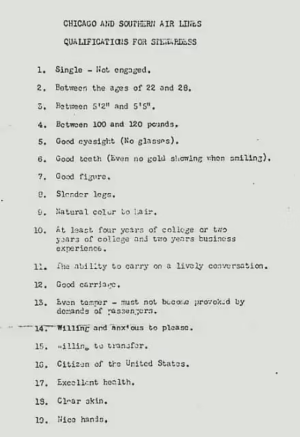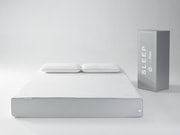Exposed: The Outrageous Flight Attendant Demands from the 1950s That Everyone's Talking About
By
- Replies 6
The golden age of air travel is often remembered for its glamour and luxury, a time when flying was an event worthy of your finest attire and when the skies were traversed by the elite. However, a recent viral post has peeled back the curtain on the less-discussed aspects of this era, revealing the stringent and, by today's standards, shocking requirements for women who aspired to be flight attendants in the 1950s.
The job description from the 1950s, which has sparked widespread conversation online, paints a picture of an industry that placed a heavy emphasis on the physical appearance and demeanour of its female cabin crew. The list of prerequisites for potential flight attendants was not only exhaustive but also intrusive, focusing on attributes such as height, weight, skin, and teeth. Women were expected to weigh between 100 and 120 pounds, possess a 'good figure' and 'slender legs,' have 'nice hands,' and maintain 'good carriage.'
The role demanded more than just physical attributes; it also required a particular type of personality. Flight attendants needed to have the 'ability to carry on a lively conversation' and be 'willing and anxious to please.' These phrases, which now raise eyebrows and provoke criticism, reflect the gender expectations of the time. One commenter on the viral post remarked, ''Willing and anxious to please' wtf? - Something about that feels so manipulative,' highlighting the discomfort with the outdated attitudes towards women in the workplace.
The discussion online has brought forward personal anecdotes, with several people sharing stories of relatives or acquaintances who were flight attendants during that era. One user recounted how their mother, a flight attendant in 1964, was subjected to a strict diet and daily weigh-ins and was even encouraged to smoke to maintain her slender figure. The rigorous standards extended to posture and manners, with the 'pile of books on the head' walking test used to ensure gracefulness.
Interestingly, despite the stringent list of requirements, some women managed to secure these coveted positions with less than the stipulated educational or experience prerequisites, often because they fit the desired physical and aesthetic profile. This highlights the era's focus on appearance over qualifications, a practice that would be considered discriminatory today.
The role of the flight attendant has evolved significantly since the 1950s. Former pilot Dan Bubb provided context to the changing uniforms and standards over the decades. Initially 'military inspired,' the attire became more glamorous and feminine in the 1950s and 60s, often designed by famous clothing designers. By the 1970s, the uniforms featured bright colours and patterns, but as time progressed, practicality took precedence to accommodate the long shifts and varied responsibilities of flight attendants.
The recruitment of registered nurses in the early days of commercial aviation was also a strategic move by airlines. It was believed that nurses could provide comfort and care to passengers who might feel sick or uncomfortable during flights, a nod to the infancy of commercial air travel and the anxieties that accompanied it.
The industry's transformation from these discriminatory practices to the current standards is a testament to the progress made in workplace equality. Today, flight attendants are valued for their professionalism, rigorous training, and ability to ensure passenger safety, with the outdated height and weight restrictions largely a thing of the past.
As we reflect on these historical requirements, it's essential to acknowledge the strides taken towards creating a more inclusive and fair work environment. The viral post serves as a reminder of how far we've come and the importance of continuing to challenge and change discriminatory practices in all industries.
 We'd love to hear from our readers, especially those who have memories or family stories from the era of aviation's golden age. How do you feel about the evolution of the flight attendant role? Share your thoughts and stories in the comments below!
We'd love to hear from our readers, especially those who have memories or family stories from the era of aviation's golden age. How do you feel about the evolution of the flight attendant role? Share your thoughts and stories in the comments below!
The job description from the 1950s, which has sparked widespread conversation online, paints a picture of an industry that placed a heavy emphasis on the physical appearance and demeanour of its female cabin crew. The list of prerequisites for potential flight attendants was not only exhaustive but also intrusive, focusing on attributes such as height, weight, skin, and teeth. Women were expected to weigh between 100 and 120 pounds, possess a 'good figure' and 'slender legs,' have 'nice hands,' and maintain 'good carriage.'
The role demanded more than just physical attributes; it also required a particular type of personality. Flight attendants needed to have the 'ability to carry on a lively conversation' and be 'willing and anxious to please.' These phrases, which now raise eyebrows and provoke criticism, reflect the gender expectations of the time. One commenter on the viral post remarked, ''Willing and anxious to please' wtf? - Something about that feels so manipulative,' highlighting the discomfort with the outdated attitudes towards women in the workplace.
The discussion online has brought forward personal anecdotes, with several people sharing stories of relatives or acquaintances who were flight attendants during that era. One user recounted how their mother, a flight attendant in 1964, was subjected to a strict diet and daily weigh-ins and was even encouraged to smoke to maintain her slender figure. The rigorous standards extended to posture and manners, with the 'pile of books on the head' walking test used to ensure gracefulness.
Interestingly, despite the stringent list of requirements, some women managed to secure these coveted positions with less than the stipulated educational or experience prerequisites, often because they fit the desired physical and aesthetic profile. This highlights the era's focus on appearance over qualifications, a practice that would be considered discriminatory today.
The role of the flight attendant has evolved significantly since the 1950s. Former pilot Dan Bubb provided context to the changing uniforms and standards over the decades. Initially 'military inspired,' the attire became more glamorous and feminine in the 1950s and 60s, often designed by famous clothing designers. By the 1970s, the uniforms featured bright colours and patterns, but as time progressed, practicality took precedence to accommodate the long shifts and varied responsibilities of flight attendants.
The recruitment of registered nurses in the early days of commercial aviation was also a strategic move by airlines. It was believed that nurses could provide comfort and care to passengers who might feel sick or uncomfortable during flights, a nod to the infancy of commercial air travel and the anxieties that accompanied it.
The industry's transformation from these discriminatory practices to the current standards is a testament to the progress made in workplace equality. Today, flight attendants are valued for their professionalism, rigorous training, and ability to ensure passenger safety, with the outdated height and weight restrictions largely a thing of the past.
As we reflect on these historical requirements, it's essential to acknowledge the strides taken towards creating a more inclusive and fair work environment. The viral post serves as a reminder of how far we've come and the importance of continuing to challenge and change discriminatory practices in all industries.
Key Takeaways
- A list of requirements for 1950s flight attendants, focusing on physical features and personal attributes, has been widely shared and criticised online.
- The specifications include being within a certain weight range, having a 'good figure', 'slender legs', and 'nice hands', as well as being 'willing and anxious to please'.
- Commentators have expressed disgust at the outdated and discriminatory standards, noting that such hiring practices would be illegal today.
- The role and presentation of flight attendants have evolved over time, with uniforms changing from 'military-inspired' to more relaxed and practical attire to suit the demanding nature of the job.








